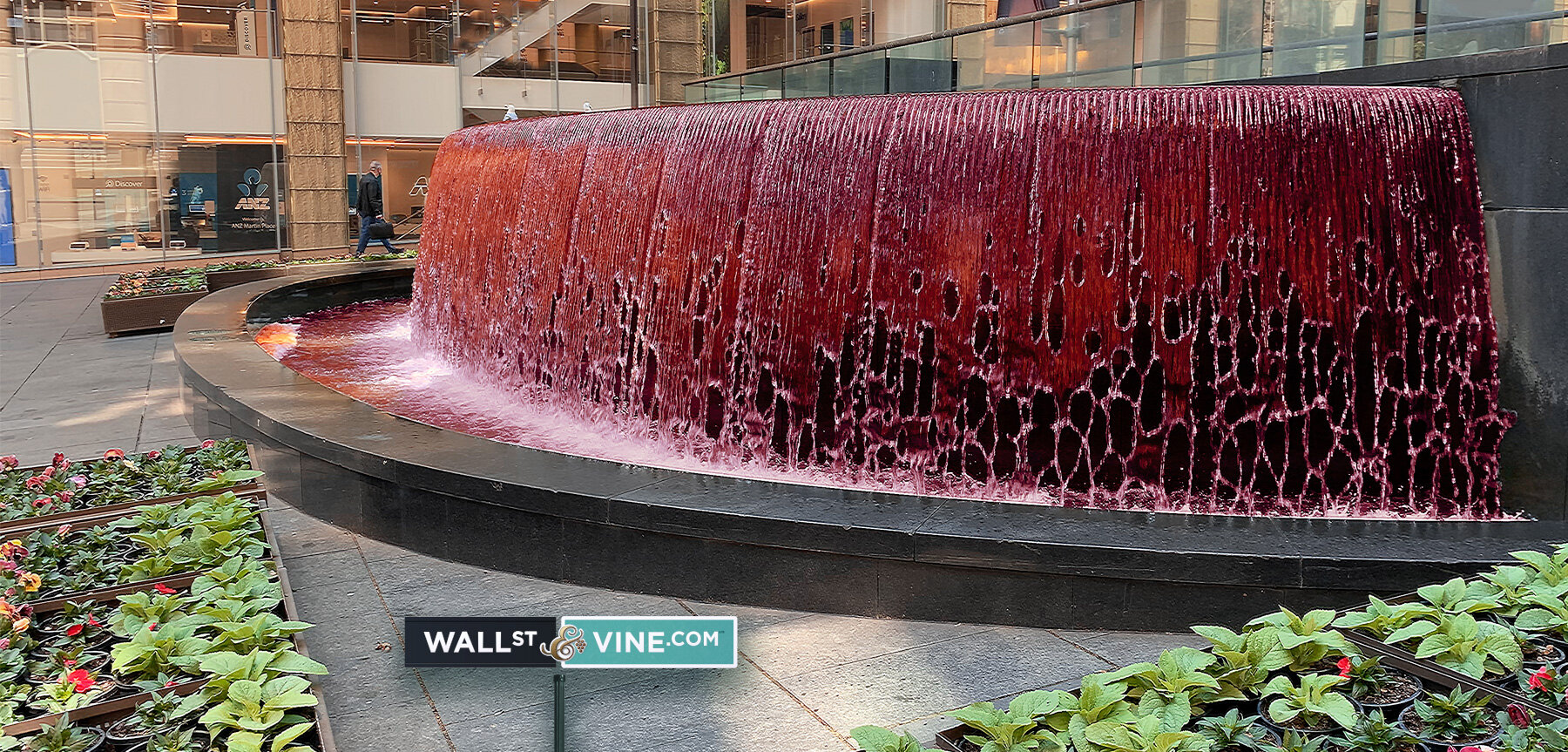Did Sydney’s famous fountain from the movie The Matrix, just turn water into bad wine?
Sydney’s Martin Place Fountain is rife with cork taint! It’s coloured red here in the photo only for editorial purposes!
You are going to file this under the odd things to learn from putting your nose in a wine glass.
Recently, as I walked through Martin Place in Sydney, I was overcome by the most disgusting smell! There was a pungent onslaught of mould and wet, dirty dog wafting straight from the fountain. This is the famous fountain from the movie The Matrix. You might remember the scene where Laurence Fishburn is explaining the Matrix to Neo (Keanu Reaves) for the very first time. They are standing by this fountain when Keanu is distracted from their conversation by watching a woman in a red dress pass by.
The stench hits me. Oh no, not again? I’ve had the same thing happen to me visiting the Detroit airport, where there is a huge imposing fountain that is the centrepiece of the Delta Terminal and its smell is retch-worthy putrid. It seems both of these fountains are contaminated with cork taint or trichloroanisole (commonly known as TCA). Through my Master of Wine studies, this contamination is unfortunately one that my nose is well acquainted with.
Managers Beware! It turns out that some, well-intentioned cleanliness is bad for business.
I sometimes have the same experience with fresh vegetables at the supermarket – in particular, bags of peeled small carrots and Lebanese cucumbers. When I lived in New York City, the water tank that sat atop and served my building in the West Village was contaminated. When I visited Bruny Island earlier this year, the water source serving our lodge was contaminated and the smell was so intense that I could not brush my teeth with the water.
You ask, how could this be? Although it’s counterintuitive, being meticulous about cleanliness is often the cause of TCA. My guess is that the cleaning team that is responsible for cleaning in Martin Place actually caused the contamination by using bleach-based cleaning agents. When some bacteria or fungi are subject to bleach, fungicides or insecticides, their defence mechanism can alter these compounds and create TCA in the process.
Humans have a remarkable sensitivity to cork taint, with people able to detect TCA via smell between two and five parts per trillion, and some even below one part. That’s like being able to identify one teaspoon of water from 1,000 Olympic-sized swimming pools.
“Typically 3 to 5 per cent of all corks used today are tainted, which means the wine is faulty… could you imagine Proctor & Gamble’s CEO accepting a five per cent fault rate for a product line?”
With cork taint, there is no way to protect yourself from its foul smell. Sometimes, I wish I was like Clark Kent, who could protect himself from the effects of Kryptonite with lead. Typically 3 to 5 per cent of all corks used today are tainted, which means that the wine is faulty; this number used to be higher. This product fault rate would never be tolerated in a large fast moving consumer goods company. Could you imagine Proctor & Gamble’s CEO accepting a five per cent fault rate for a product line? Australian wine business leaders have responded by switching a lot of wine to screw cap closures, but faulty wine product remains a global issue that is ripe for a technology innovation solution.
The hardest thing about wine that is faulty from cork taint is that most consumers don’t know what they are experiencing. Consumers open or order a wine and think to themselves that they won’t buy that bottle again because they didn’t like it. Or they wonder if something is wrong, but they don’t have the confidence to complain. This is why I invite you all to walk past the Martin Place Fountain in Sydney or the fountain in the Delta Terminal at Detroit Airport and report back. Once you’ve smelled cork taint, you’re equipped to take action because you’ll always remember it. And, I would be comforted if I had others I could share this olfactory pain with…. and if enough of us banded together we could lobby to fix the most offensive public smells, starting with corked fountains.
If you experience a strong musty smell from a bottle of wine served in a restaurant, send the bottle back. Well, maybe not if you ordered a Châteauneuf-du-Pape because then it is could be Brettanomyces … which is not universally considered a wine fault and will be a topic for a future post. And don’t forget to always keep your nose on high alert in the vegetable aisle at the supermarket.
As a cork taint/TSA-sensitive person, I’m hoping to inspire app developers to create a heat map of places to avoid. What surprising places and in what products are you finding the musty smell of cork taint? What places, if any, have rectified it? Let me know in your comments below. It might be interesting to discover what lengths and investments in time, resources and staff training are needed to improve customer experiences. As an analogy, when TCA contaminates a winery, a thorough and expensive cleaning effort is required, along with ongoing vigilance.
Last but not least, does anyone know who to contact in the City of Sydney to help fix this fountain’s contamination? It would be such a shame if the investment in public funds to create and care for the fountain actually led to people beginning to avoid it.


